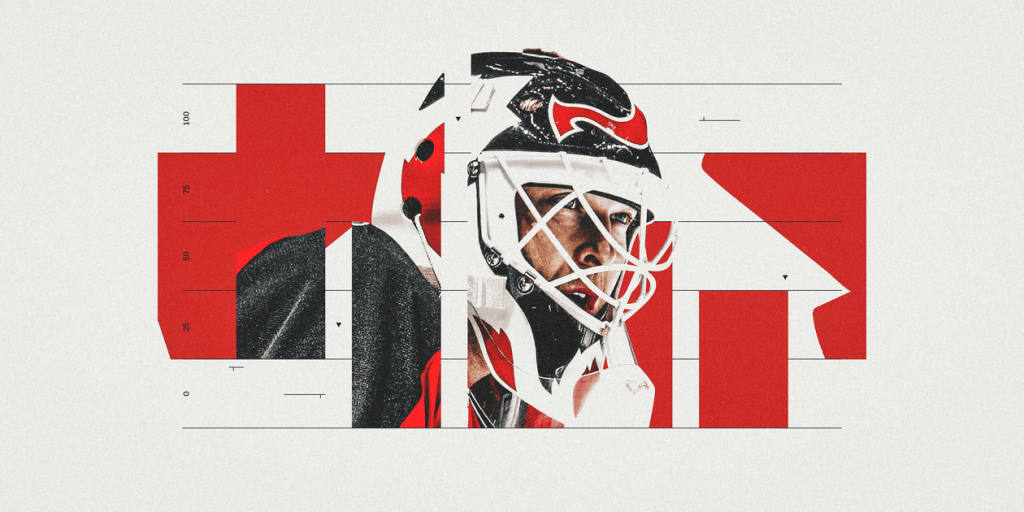Their numbers have been dwindling, dramatically, almost every year now. From 73 percent of the NHL, to 51, and now down to half that in the span of less than 20 years.
While it may feel hyperbolic to call it a crisis in Canadian hockey, it’s certainly a troubling notion that now regularly registers in the national consciousness — especially when their hockey teams head to a major international tournament, as they do this week at the 4 Nations Face-Off.
After owning the crease for nearly a century, the Canadian goalie is apparently becoming outmoded.
The pressing question, throughout international hockey circles, is: How did this happen? How did Canada go from the world’s standard bearer — the country of Jacques Plante, Ken Dryden, Patrick Roy and Martin Brodeur — to being outclassed at the most important position in its national sport?
And how can they fix it?
The end of Canadian dominance
Historically, Canada had always excelled in goal at hockey’s highest levels — even beyond its success at other positions. All of the five goalies with the most wins in NHL history, for example, are Canadian. And Sweden’s Henrik Lundqvist is the only non-Canadian to crack the top 10.
In recent years, having Brodeur, Roberto Luongo or Carey Price in net at all of the major international events was a sizable advantage, and a big reason Canada won gold at the Winter Olympics (2002, 2010 and 2014) and World Cup (2016).
As recently as 2000, Canada was so overwhelmingly in control at the position that two-thirds of all games played in the NHL were by goalies from the country. Today, however, Europeans are twice as prevalent as Canadians, and the Americans are on the verge of passing Canada.
The trend has become so pronounced that it roughly equates to Canada losing a starting position in the NHL every season.
It’s a shift that’s especially evident among the game’s elite goalies. A Canadian, for example, has won only one of the past eight Vezina trophies as the league’s top goaltender. Prior to 1993-94, Canadians had won the award an incredible 62 of 67 times.
What’s reignited this conversation this season is Canada’s three netminders for the 4 Nations tournament, the first best-on-best event since 2016, are underwhelming names: Jordan Binnington, Adin Hill and Sam Montembeault, who rank 14th, 25th and 29th in wins in the NHL since 2021-22.
Canada’s competition at the tournament is telling. The top two goalies in wins in that same time frame — Connor Hellebuyck and Jake Oettinger — are both American. Finland has Juuse Saros (sixth), and Sweden is led by Linus Ullmark (10th) and Jacob Markstrom (seventh), who will miss the event due to injury.
The remainder of the top 10 are all from Russia, a nation that won’t be participating in the event due to the war in Ukraine.
Cam Talbot, at 37 years old, leads all Canadians with 92 wins with four different teams spread over the past four seasons.
“It’s kind of mind-boggling,” said Brodeur, the NHL’s all-time leader in wins, in a recent radio interview about Canada’s struggles in goal.
Why other countries are taking over
The reasons behind this trend are complex and have befuddled hockey people in Canada for more than a decade. Canada, after all, remains a dominant power at other positions, with Connor McDavid, Nathan MacKinnon and Cale Makar among the best players in the world.
Part of the answer is in how Canada’s competition has adapted, beginning with European nations in the 1990s.
Dominik Hasek’s success in the NHL 30 years ago was a revelation in the goalie world as the Czech with the slinky spine won six Vezinas and in 1997 became the first goalie named league MVP in the game’s modern era.
When he stole the gold medal at the 1998 Olympics in Nagano, proving unbeatable against hockey’s traditional juggernauts, it led to a goalie-development arms race, both in the NHL and among other countries.
Canada still produced the vast majority of NHL goalies during Hasek’s era of dominance. He was viewed as an outlier. The focus at the time was on the Made-in-Canada butterfly technique that relied on a prescriptive model of dropping to your knees and blocking the puck.
That style was famously employed by Roy, who won four Stanley Cups between 1986 and 2001, and adopted by other students of goalie coach Francois Allaire, who revolutionized the position in the 1980s.
A run of French Canadian goalies — led by Roy, Brodeur, Luongo, Marc-Andre Fleury, Felix Potvin, J-S Giguere and others — owned NHL creases. And they made Canada nearly unbeatable on the world stage.
But small countries like Czechia, Finland and Sweden, all with populations of 10 million or less, saw something in Hasek. The sports leaders of those nations believed getting better in goal would allow them to compete with superpowers like Canada and Russia.
So they poured resources into goalie development and coaching. And they began to win.
What NHL teams soon found was this new breed of European goalie who played differently than Canadians. An intense focus on teaching what is one of the most technical and mentally demanding positions in pro sports was paying off, especially in the Nordic countries, where resources could be pooled and disseminated to every age group through their club team system.
After a stretch of dominance from Finns and Swedes in the 2000s — led by Lundqvist’s rise from seventh-round pick to Hall of Famer — other countries began to copy those models. Today, Russia and the United States are making the biggest gains. And Canada lags behind.
Where Canada has fallen short
One issue goalie development experts point to is the intense professionalization occurring in Canadian hockey at young ages, something that doesn’t always lend itself to grassroots development.
At the elite level, winning is often the primary goal, even with kids as young as 7 or 8 years old. This leads to “super teams” where only one goalie is given most of the opportunity, limiting the number of kids playing the position. It also shows up in Canadians hewing to tradition and resisting new development strategies, like smaller nets and cross-ice play for younger children.
Hockey Canada has been trying — and it instituted cross-ice play for younger age groups in 2017 — but it is fighting an uphill battle against many parents and coaches.
“There’s really no focus on goaltending development in minor hockey at all,” says Rob Gherson, a former Washington Capitals draft pick and pro goalie who has coached in Toronto’s top youth leagues for more than a decade. “That’s one area we’ve definitely fallen behind. Other places — Sweden, the U.S., Russia — they’ve put money into goaltending, and they’ve put a focus on trying to develop goalies.
“In Canada, coaches are under a ton of pressure because the focus in minor hockey here is about winning. And it’s crazy. It’s essentially like these kids are becoming professionals at 8 years old.”
This does children a disservice, Gherson says, as fewer are allowed to even try the position. And the ones who do get to play often don’t reach their potential.
“At the end of the day, they get a million plastic trophies or medals,” he says. “They don’t get anything out of it.”
In Sweden, by contrast, players almost always play multiple positions, which allows them to become more well-rounded athletes and understand the sport from multiple perspectives. They also force a goalie rotation, so that it’s not simply the most talented 9-year-olds playing every minute.
USA Hockey’s development staff has been collaborating with Sweden in recent years and now focuses on getting as many kids as possible to try the position. Their aim by 2030 is to have 10 percent of all youth players be goalies.
They are also more widely adopting equipment innovations that allow players to swiftly swap out gear so kids can “share” a start. Getting a goal, assist and save in a game is their new-school version of a Gordie Howe hat trick.
“People think you have to be a full-time goalie at 5 years old when you’re learning how to skate,” USA Hockey head of goalie development Steve Thompson says. “That’s something we strongly resist the families to do. We want them to be a hockey player first and a goalie second and really understand the entire game.
“We’ve seen some of our national team goalies that didn’t start (in goal) full time until they were 13 or 14 years old. The general thought is that that’s wild and how on earth is that possible? But the more we’re seeing it, the more we’re starting to really buy into the fact that those are the best athletes: The ones that are well-rounded before they dive full in.”
Some of these approaches have met firm opposition in Canada, where parents and coaches want to teach the way they learned decades ago.
“In minor hockey at 9, 10 years old, it’s a top-shelf competition,” Gherson says, using the resistance to smaller nets for children as an example. “Whatever team can shoot high the most is going to win because the goalies can’t reach the crossbars.
“It’s like they’re playing a different position. When you’re coaching with those kids, you almost have to teach them something different (than what they should be learning).”
Gherson says Canada has the kids willing to learn the position and the resources to support them, with many parents shelling out tens of thousands of dollars on camps, training and equipment every year.
But that’s not working.
“(Kids) are going into the factory of the goalie school,” Gherson says, explaining that many goalie camps cost upwards of $1,000 a week, which further limits the pool of goalies. “We spend so much money here (on goaltending). It just should be better.”
How other countries do it
When Andrei Vasilevskiy first arrived at Paul Schonfelder’s goalie clinic in Ottawa in 2010 as a 16-year-old, he skated and moved in the net differently than goalies who’d grown up being trained in Canada.
The future Vezina winner was raw in terms of efficiency and structure on the ice, Schonfelder says. But Vasilevskiy had a unique ability to read plays and was a remarkable athlete at 6-feet-4.
It was easy to see his potential, even if the Canadian goalies alongside him were more technically sound.
Looking back, Schonfelder, now goalie coach for the Carolina Hurricanes, sees the young Vasilevskiy as a prototype.
“He’d already developed a strong athletic piece in his game. And really all that needed to be added was the structure, but it was being added when he was older,” Schonfelder says. “I find in Canada it’s the opposite.”
Schonfelder, who has worked with Hockey Canada’s goaltending development program, says Canadian goalies often look exceptional at younger ages. That’s because they focus on prescribed positions and micro movements for different scenarios from a young age, often drilling the movements during long practice sessions with a dedicated coach.
“We get these kids at 17 or 18 who are extremely structured and if you asked them to do a pattern in the crease, they look like a million bucks,” Schonfelder says.
What they lack, however, is the athleticism of an elite goaltender, with an ability to get outside a technical box and problem solve in game situations. “They don’t have the ability to read the game and think on their own,” Schonfelder says.
“That’s a big part of the stagnation of goaltending,” says Thomas Magnusson, Sweden’s head of goaltending development. “Shooters don’t do the same thing over and over again. They do different things. But in a goalie practice, a lot of times you see goalie coaches doing the same thing and repeat it over and over again. That’s not how the game of hockey looks.”
The Russian goalies Schonfelder has worked with, however, don’t receive this level of coaching at younger age. Instead, they’re allowed to go in the net and play.
The most effective method, says Sasha Tyjnych — the agent who discovered Vasilevskiy — is to find a good goalie with natural talent and individualize their training.
They might be more inclined to stand up in certain situations, or butterfly in others, but ultimately the goal is to improve what already works for them. This fits with the USA Hockey’s current approach, which encourages originality.
“For me, this is why Russian goalies are better right now,” Tyjnych says.

When Andrei Vasilevskiy first came to Canada to be trained as a teenager, he was a raw prospect. But later, he developed into one of the league’s best. (Mike Carlson / Getty Images)
In consulting with goalie coaches across the country, Hockey Canada’s director of player development Corey McNabb says there’s consensus that the intense focus on technique at a young age is problematic.
“If you have the athleticism and physical literacy first, the technique is easier to apply later on,” McNabb says.
But getting hockey parents and youth organizations in Canada to buy into this kind of change in mindset can be difficult.
“We’re in a rush to try to get to best-on-best instead of providing more kids with the chance to play at a higher level for a longer period of time,” says McNabb. “Unfortunately, in our system there are a lot of kids who are told they’re not good enough too early. And we don’t really know at 14 years old who’s going to be the best.”
The all-encompasing nature of Canada’s national sport might also be a hindrance.
As youth hockey has become a year-round enterprise at the elite level — between rep teams, summer travel teams and development camps — some argue that the outcomes can be counterproductive.
Jon Elkin, director of goaltending for the Pittsburgh Penguins, has run summer goaltending schools in the Toronto area since the early 1990s. He argues that for goaltenders, specifically, hyper-focused training will eventually lead to diminishing returns. Elkin believes goalies should participate in other sports to learn different patterns of movement and reaction to improve overall athleticism.
The American and European goaltenders that attend Elkin’s youth camps tend to participate in more sports than the Canadian kids, to their benefit, he says.
“It’s so fast, and there are so many broken plays and guys can shoot the puck. You’ve got to be able to move, change direction, stretch. Get up and down, and have great reflexes,” Elkin says. “So anything that you can do to encourage that is important.”
Compounding Canada’s overly selective approach is the size of goalies at the elite level. The average NHL netminder this season is 6-3, for example, and it’s become common for many pro netminders to be 6-5 or taller.
With fewer kids getting time to develop in Canadian youth hockey leagues, an approach focused only on winning can end up missing on kids who might be slow in growing into the right body types.
“We lose so many kids for silly reasons that could be goalies,” Gherson says. “We’re just not giving them a chance.”
The junior leagues issue
Canada’s struggles extend beyond the youth level, however. As teenagers, the best Canadian goalies are often playing in mini-NHL environments in junior leagues where, at 17 or 18 years old, they might be backing up goalies two or three years their senior. Many of those backups rarely play during these pivotal development years.
The junior leagues also typically rely on goalie coaches who are part time and low-paid, some earning as little as $7,000 for a full season’s work.
Even Canada’s best junior goalies may get only one or two seasons as a starter before they jump to the pro leagues, where winning games again trumps development.
“Our structure in some ways is hurting the potential development of young goalies,” McNabb says.
European and American goaltenders, meanwhile, are often able to play in less competitive environments for longer, either in lower-tier leagues or by going the college route.
This professionalization of the position impacts coaching, too. Many of the world’s top goalie coaches are Canadian, but they often work for NHL teams, other pro teams or their own goalie schools.
Hockey Canada has had a difficult time retaining goaltending consultants because they are so frequently recruited by NHL teams, McNabb says. And internationally, Canada is still widely viewed as a leader when it comes to goaltending instruction.
The majority of the young goalies who attend Elkin’s camps each summer are now from the United States, Russia, and other European countries, he says.
But guidance from a governing body can be key. Case in point: Magnusson, who has overseen Sweden’s goaltending program for many years. “He’s done a really good job and it comes down to consistency to what they’re teaching, how they’re teaching it, why they’re teaching it,” McNabb says of Magnusson.
The standardization of coaching, and quality control, that has become a feature of the Finnish and Swedish approach — and something the U.S. has been rapidly adopting — is not currently the norm in Canada.
“Canada has not been able to do things on a national scale,” Magnusson says. “It still looks, to me, like it did 10, 11 years ago. There’s a lot of goalie coaches, yes, but they’re doing different things, which means a goalie going up the system, from youth to juniors to pro ranks, gets different messages.”
This means there’s rarely a consensus about how to teach at the lower levels.
“With all the private companies, private goalie coaches — and also the competition for (NHL) jobs in the professional goalie coach market — they need to have their own way of doing things,” Magnusson says. “They have to promote themselves. ‘This is my way. This is my terminology.’ Which mixes things up for goalies.”
Hockey Canada acknowledged this reality close to a decade ago, says McNabb. Upon witnessing Canada’s decline in goalie dominance, the organization set out to find a fix.
In 2019, Hockey Canada implemented a policy that urged youth teams to avoid having a full-time goalie before the age of 10. But it’s not an enforceable policy.
For ages 10 and older, Hockey Canada encourages goalies to alternate games, and to play forward or defense rather than sit on the bench when it’s not their turn to play in net. Again, it’s not a widely adopted concept.
A work group of goalie coaches from across the country helped Hockey Canada develop a three-tiered process to train goalie coaches. The first level focuses on grassroots basics, meant for teams that don’t have a dedicated goalie coach. The second level is intended for a more advanced perspective on skillsets, tactics and game play.
In the past two years, close to 2,500 coaches from across Canada have attended the level one and level two clinics, McNabb says.
A third level of training allows coaches to receive goalie coach certification. Around two dozen coaches are selected to attend a camp in Calgary each year. So far, 120 coaches have received that certification.
“We can’t be complacent in this area,” McNabb says. “We need to continue to get better and push the pace and try to get more goaltenders to the highest level.”
Can Canada turn the tide?
Amid Canada’s declining dominance in goal, there are reasons for optimism. Seven of the past 10 Stanley Cup-winning teams have had a Canadian goalie.
And this season, some of the top save percentages in the NHL have been put up by Canadians, like Mackenzie Blackwood, Logan Thompson and Darcy Kuemper.
The past two seasons, Canadian goalies have actually posted a save percentage slightly higher than the NHL average.
“It’s not the end of the world here,” says Elkin. “It’s not as bleak as I think it’s made out to be.”
There is a cyclical nature to this reality, he argues: “There’s no reason why we can’t dominate again.”
McNabb believes Canada might be on the verge of reversing the trend, pointing to a pipeline of young goalies coming through Hockey Canada’s system.
“I think right now at the high-performance level, it’s looking really good for the future,” McNabb says.
According to The Athletic’s latest ranking, however, only four of the top 20 23-and-under goalie prospects are Canadian.
And they’re up against USA Hockey’s increasingly aggressive approach, including its goal of having 50 percent of NHL minutes played by Americans in the near future.
Several of Canada’s current starters like Talbot, Kuemper and Fleury are about to age out of the league, and whether they’ll be replaced by countrymen — or more Europeans and Americans — is an open question.
“Canada will always produce goalies,” Magnusson says. “It’s just a matter of how many.”

GO DEEPER
Why Canada is giving Jordan Binnington the 4 Nations net with ‘full confidence’: ‘Binner’s a winner’
(Illustration: Dan Goldfarb / The Athletic. Photo: Chris McGrath / Getty Images)





